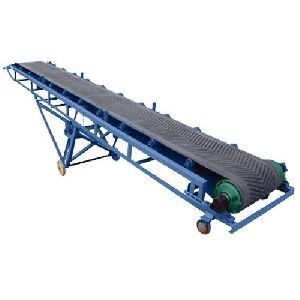
The mobile conveyor is divided into a belt mobile conveyor and a bucket mobile conveyor, the bottom of the conveyor is equipped with a universal wheel, which can move at will according to the stacking position of the material, the mobile belt conveyor is used in the environment with a small conveying inclination angle, the mobile bucket conveyor is used in the environment with a large conveying inclination angle, and the mobile bucket conveyor, a small bucket is installed on the conveyor belt, and the material will not fall back when the conveying inclination angle is large.
The main features of the mobile belt conveyor: high bearing capacity, long life (up to 10 years), structure gathering, small footprint (can be reduced by more than 50%), light weight, small volume (can be reduced by 50%), especially the vertical transmission structure form, suitable for use in underground coal mine transportation machinery.

Generally, the main parameters are determined according to the requirements of the material handling system, the various conditions of the material loading and unloading location, the relevant production process and the characteristics of the material.
1. Conveying capacity: The conveying capacity of conveyor equipment refers to the amount of material transported per unit time. When conveying bulk materials, it is calculated based on the mass or volume of materials conveyed per hour; When conveying finished items, it is calculated based on the number of pieces conveyed per hour.
2. Conveying speed: Increasing the conveying speed can improve the conveying capacity. When the conveyor belt is used as the traction part and the conveying length is large, the conveying speed is increasing day by day. However, high-speed belt conveyors need to pay attention to vibration, noise, starting, braking and other problems. For conveyors with chains as traction parts, the conveying speed should not be too large to prevent the increase of dynamic load. For conveyors that carry out process operation at the same time, the conveying speed should be determined according to the requirements of the production process.
3. Component size: The component size of the conveyor includes conveyor belt width, slat width, hopper volume, pipe diameter and container size, etc. The size of these components has a direct impact on the conveyor's conveying capacity.
4. Conveying length and inclination: The length of the conveying line and the size of the inclination directly affect the total resistance and required power of the conveyor.
TradeManager
Skype
VKontakte